This is an old revision of the document!
Table of Contents
archive beehive inspiration
The design of our observation/performance beehive is based on the blueprints of Francis Hubers' book beehive.
The Leaf Hive, invented in Switzerland in 1789 by Francis Huber, was a fully movable frame hive. The combs in this hive were examined like pages in a book. A.I. Root and E.R. Root credit Huber with inventing the first movable frame hive.
Huber's contribution was also acknowledged by Lorenzo Langstroth, inventor of the hive style that is most commonly used today:
The use of the Huber hive had satisfied me, that with proper precautions the combs might be removed without enraging the bees, and that these insects were capable of being tamed to a surprising degree. Without knowledge of these facts, I should have regarded a hive permitting the removal of the combs, as quite too dangerous for practical use. L.L. Langstroth in Langstroth on the Honey-Bee, 1860.
The frame sides were 1 and 3/8 inch wide. The hive was secured with a cord.The closed-end frame hive had many good features of a movable-frame hive. The side bars of the frame (at right) also formed the walls of the hive. Some successful beekeepers were using this hive as late as the 1890's.

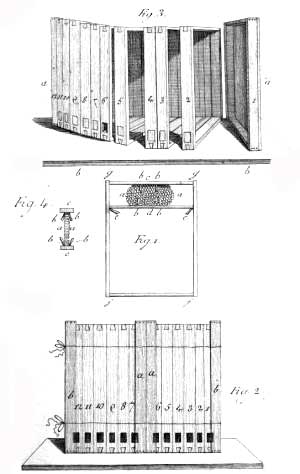
collage/drawing: Annemie Maes …………… francis huber, book beehive - design 1789
A book hive, consisting of twelve frames, all numbered, is represented fig. 2. Between 6 and 7 are two cases with lids, that divide the hive into two equal parts, and should only be used to separate the bees for forming an artificial swarm; a, two frames which shut up the two sides of the hive, have sliders, b. b.
The entrance appears at the bottom of each frame. All should be close but 1 and 12. However it is necessary that they should open at pleasure.
The hive is partly open, fig. 3. and shows how the component parts may be united by hinges, and open as the leaves of a book. The two covers closing up the sides, a. a
Fig. 4. is another view of fig. 1. a a. a piece of comb to guide the bees; b b. pegs disposed so as to retain the comb properly in the frame; c c. parts A. of two shelves; the one above is fixed, and keeps the comb in a vertical position; the under one, which is movable, supports it below.)
The leaf or book hive consists of twelve vertical frames or boxes, parallel to each other, and joined together. Fig. 1. the sides, f f. f g. should be twelve inches long (30 cm), and the cross spars, nine or ten (approximately 23 to 25 cm) the thickness of these spars an inch (2.5 cm), and their breadth fifteen lines (1 line=1/12th in. 15 lines=1 1/4 in.=32mm). It is necessary that this last measure should be accurate; a piece of comb which guides the bees in their work; d. a movable slider supporting the lower part; b b. pegs to keep the comb properly in the frame or box; four are in the opposite side; e e. pegs in the sides under the movable slider to support it.
New Observations on the Natural History Of Bees by François Huber
Nouvelles Observations sur les Abeilles - Françoius Huber
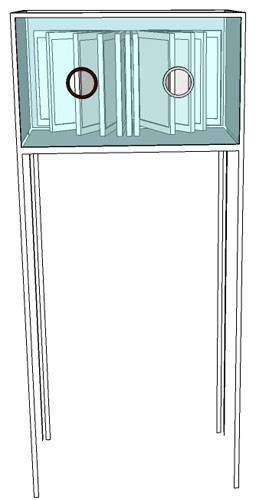
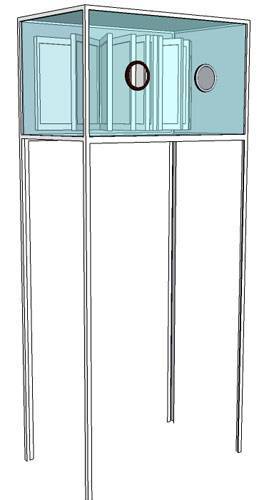
first design for the observation book beehive, drawing: Joeri Bultheel
In the Bee Archives or Stories from the Drying Room the city honeybees are the main performers.
The sonification of the bees' actions creates a real-time subtle soundtrack for the life in the hive.
An OpenStructure observation hive illustrates values such as community building and collective decision making among the bees.
the BEE arcHIVE
Bee Monitoring research and the Bee arcHIVE sculpture
⇨ projects on the crossroads of art and science
⇨ how can we transfer the complexity of the beehive to the auditive or visual domain?
⇨ With the BEE arcHIVE, we try to sonify the rythm of the hive along a bee-season
observation beehive
⇨ behaviour, reactions and interaction with environmental factors
⇨ visualize and sonify empirical aspects of the hive that can’t be perceived without opening the hive
⇨ provide information on the bee colony in the form of an arwork : a sound sculpture
a bee colony is complex system: chaotic, dynamic, collaborative
⇨ monitor the bees’ current condition
⇨ monitor and find patterns in the bees’ behaviour
⇨ use scientific tools, ICT: sensor networks, databases, pattern recognition programs
complexity of beehive is difficult to capture
⇨ t°, hu & CO2 sensors : they give only an temporary impression but no real interpretation of the life in the hive
⇨ t°, hu and CO2 data can be stored over time and visualized in graph-timelines that can evoke patterns on short, middle and long term
the bee archive : an artwork to make a complex system tactile via sound :
12 hive-frames
12 contactmicrophones
12 channels IN
1 mixer
2 channels OUT
⇨ buzzing drones and vibrations in the hive will make the contactmicrophones resonate (volume can be an indication of the size of the colony)
⇨ bees will touch the wires of the mikes (amount of toc’s indicates activity in the hive)
⇨ bees will cover the microphones and wires with propolis (filtering in the sound, some sounds will become muted over time)
⇨ timbre will change as the colony moves around in the hive (broodnest)
open structures bee observatory
Discussed with Gert Aertsen (http://atkn.org/dk/index.php/Version) the design of the book beehive, and we decided to work together on the project, and fit it into Gert's research into Open Structures (http://openstructures.net).
The idea is to adapt the concept of the book beehive to the concept of an automated archive library in which different sections can be opened and closed by a manual pulley from the outside of the glass cage.
Later, when discussing possible observation-hive technology, Elias joined the conversation. For now we got hold on the idea of building in a flatbed scanner (in an hive-frame) to make slit-scans (observations in time) of the colonies' comb building and behaviour.
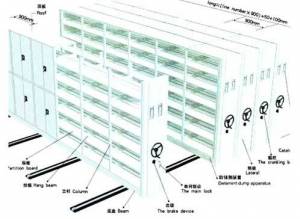
mechanical archive library
This is the idea to work on for the beehive. We will realize it with Open Structures principles. In a combination of wood and inox.
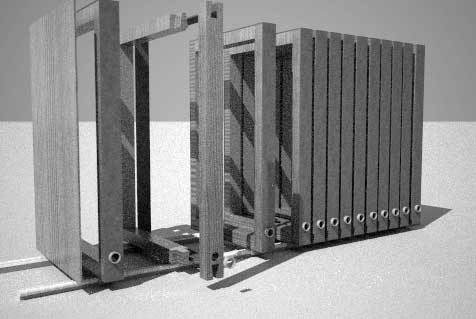
second design observation beehive, drawings Gert Aertsen
materialen en afwerking
hive
- model couveuse, welke maten, welke dikte
- basis of an OpenStructures geometrical grid, printed in fablab on birchwood
- de gaten voor de handschoenen, de scharnieren bovenaan
- de plexi buis + uitsnede
- inox omhulsel voor de frames
- Igus geleiders en transportwagentjes
- het metalen onderstel
technologie
- piezo op hout frame
- piezo gelast ijzerdraad + springveren
- piezo onder vliegplank
- voorversterkers
- custom made mengpaneeltjes
- 2 speakers
wood and wood protection
Een mogelijke houtbescherming is een mengsel van zuivere bijenwas met lijnolie en (natuurlijke) terpentijn. Elk 1/3 deel. Steeds eerst een laag olie aanbrengen en daarna een of meerdere lagen van dit wasmengsel. Zodra de laag enigszins is aangedroogd moet er snel goed worden gepolijst.
Een heel bijzondere afwerking kunnen we nog krijgen door propolis te gebruiken. Dit is de kitachtige hars die bijen gebruiken om hun raten af te dichten en aan elkaar te plakken. Van propolis zijn de goede eigenschappen al duizenden jaren bekend. Het remt virus- en andere ontstekingsoorzaken. Bestrijdt pijnen enz. De beroemde vioolbouwers gebruikten het al in hun lakken terwijl ook kunstschilders het door hun verven mengden.
Wij kunnen van de desinfecterende eigenschappen gebruik maken door het op hout te gebruiken waarop we anders schimmels zouden kunnen verwachten. Door het in een olie op te lossen kan het gebruikt worden. B.v. voor hout dat we willen gebruiken voor contact met levensmiddelen. We moeten dan natuurlijk een bijpassende olie gebruiken.
http://www.de-houtdraaier.nl/afwerken.htm
Propolistinctuur als basis voor houtbescherming
• Breng 100 g propolis over in koffiefilters (+/- 5)
• Sluit de filters af met witte katoenen koord.
• Week gedurende 14 dagen in 1 liter 96% methylalcohol (indien tinctuur voor orale inname: ethylalcohol)
• Druk de buideltjes uit en gooi weg.
other technology to implement in the bee observatory
Technology to incorporate in the bee observatory: audio (piezo's and other ceramic microphones) and video (flatbed scanner). All technology connected to a small PC board (mini ITX computer for visuals, beagleboard for the audio).


A dismantled flatbed scanner, to build into a beehive frame. And the light path used by the scanner-technology.
preliminary research for other presentation structures
Obsessed as I am by patterns and shapes in nature (and thus also by the perfectly build bees'comb), I was thinking of a sculpture based on natural shapes for my presentation display. The hectagonal cells of a geodesic dome, the mathematical precision of shapes following a Fibonacci number sequence, the ultimate perfection of some flower heads or seedpods: they all generate so many ideas that it becomes difficult to make the right choice.
All components of the display should be ecological, by preference out of recycled materials and of course with the smallest footprint possible.
These sketches present my first research on the design:
drawing: Joeri Bultheel
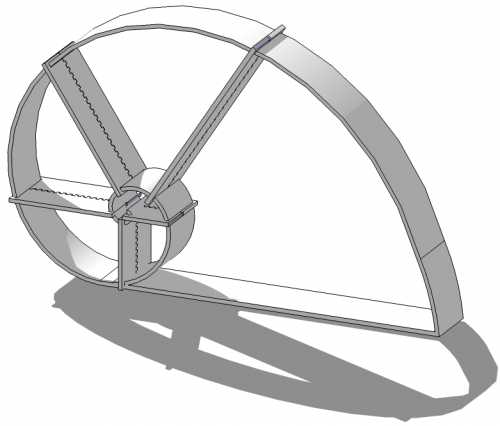
The idea was to construct the Fibonacci caracol out of recycled cardboard. The supports would be lasercut at Timelab out of 3mm multiplex. The whole structure would be very flexible and easy to break down and store away - also easy to travel with.
